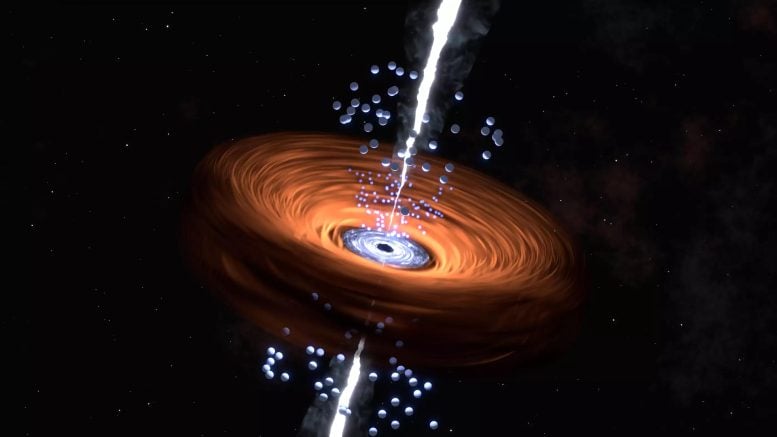Surprisingly Massive Early Universe Black Holes Challenge Cosmic Theories


Artist’s impression of the bright core region of a quasar, an active galaxy. The supermassive black hole in the centre is surrounded by a bright disk of gas and dust. The dust component further out can obscure the view of the interior and shines predominantly in the mid-infrared range, light that can be analyzed by the James Webb Space Telescope. A bundled, high-energy particle beam protrudes into space from the immediate vicinity of the black hole perpendicular to the disc. Credit: © T. Müller / MPIA
Surprisingly unspectacular: Black hole already weighed over a billion solar masses in the early universe despite average appetite.
Peering into the early stages of the 13.8 billion-year-old universe, the James Webb Space Telescope has spotted a galaxy as it existed just 700 million years after the Big Bang. It is puzzling how the black hole at its center could already weigh a billion solar masses when the universe was still in its infancy. The James Webb observations were designed to take a closer look at the feeding mechanism, but they found nothing out of the ordinary. Apparently, black holes were already growing in a similar way to today. But the result is all the more significant: it could show that astronomers know less about how galaxies form than they thought. And yet the measurements are by no means disappointing. On the contrary.
The Mystery of Early Black Holes
The first billion years of cosmic history pose a challenge: The earliest known black holes in the centers of galaxies have surprisingly large masses. How did they get so massive, so quickly? The new observations described here provide strong evidence against some proposed explanations, notably against an “ultra-effective feeding mode” for the earliest black holes.
The Limits of Supermassive Black Hole Growth
Stars and galaxies have changed enormously over the past 13.8 billion years, the lifetime of the Universe. Galaxies have grown larger and acquired more mass, either by consuming surrounding gas or (occasionally) by merging with each other. For a long time, astronomers assumed that the supermassive black holes in the centers of galaxies would have grown gradually along with the galaxies themselves.
But black hole growth cannot be arbitrarily fast. Matter falling onto a black hole forms a swirling, hot, bright “accretion disk.” When this happens around a supermassive black hole, the result is an active galactic nucleus. The brightest such objects, known as quasars, are among the brightest astronomical objects in the whole cosmos. But that brightness limits how much matter can fall onto the black hole: Light exerts a pressure, which can keep additional matter from falling in.
How Did Black Holes Get So Massive, So Fast?
That is why astronomers were surprised when, over the past twenty years, observations of distant quasars revealed very young black holes that had nevertheless reached masses as high as 10 billion solar masses. Light takes time to travel from a distant object to us, so looking at far-away objects means looking into the distant past. We see the most distant known quasars as they were in an era known as “cosmic dawn,” less than one billion years after the Big Bang, when the first stars and galaxies formed.
Explaining those early, massive black holes is a considerable challenge for current models of galaxy evolution. Could it be that early black holes were much more efficient at accreting gas than their modern counterparts? Or could the presence of dust affect quasar mass estimates in a way that made researchers overestimate early black hole masses? There are numerous proposed explanations at this time, but none that are widely accepted.
A Closer Look at Early Black-Hole Growth
Deciding which – if any – of the explanations are correct requires a more complete picture of quasars than had been available before. With the advent of the space telescope JWST, specifically the telescope’s mid-infrared instrument MIRI, astronomers’ ability to study distant quasars took a gigantic leap. For measuring distant quasar spectra, MIRI is 4000 times more sensitive than any previous instrument.
Instruments like MIRI are built by international consortia, with scientists, engineers, and technicians working closely together. Naturally, a consortium is very interested in testing whether their instrument performs as well as planned. In return for building the instrument, consortia typically are given a certain amount of observation time. In 2019, years before JWST launched, the MIRI European Consortium decided to use some of this time to observe what was then the most distant known quasar, an object that goes by the designation J1120+0641.
Observing One of the Earliest Black Holes
Analyzing the observations fell to Dr. Sarah Bosman, a post-doctoral researcher at the Max Planck Institute for Astronomy (MPIA) and member of the MIRI European consortium. MPIA’s contributions to the MIRI instrument include building a number of key internal parts. Bosman was asked to join the MIRI collaboration specifically to bring in expertise on how to best use the instrument to study the early Universe, in particular the first supermassive black holes.
The observations were carried out in January 2023, during JWST’s first cycle of observations, and lasted for about two and a half hours. They constitute the first mid-infrared study of a quasar in the period of cosmic dawn, a mere 770 million years after the Big Bang (redshift z=7). The information stems not from an image, but from a spectrum: the rainbow-like decomposition of the object’s light into components at different wavelengths.
Tracing Dust and Fast-Moving Gas
The overall shape of the mid-infrared spectrum (“continuum”) encodes the properties of a large torus of dust that surrounds the accretion disk in typical quasars. This torus helps to guide matter onto the accretion disk, “feeding” the black hole. The bad news for those whose preferred solution to the massive early black holes lies in alternative quick modes of growth: The torus, and by extension the feeding mechanism in this very early quasar, appear to be the same as for its more modern counterparts. The only difference is one that no model of quick early quasar growth predicted: a somewhat higher dust temperature around a hundred Kelvin warmer than the 1300 K found for the hottest dust in less distant quasars.
The shorter-wavelength part of the spectrum, dominated by the emissions from the accretion disk itself, shows that for us as distant observers, the quasar’s light is not dimmed by more-than-usual dust. Arguments that maybe we are merely overestimating early black hole masses because of additional dust are not the solution either.
Early Quasars “Shockingly Normal”
The quasar’s broad-line region, where clumps of gas orbit the black hole at speeds near the speed of light – which permits deductions about the black hole mass, and the density and ionization of the surrounding matter – looks normal as well. By almost all the properties that can be deduced from the spectrum, J1120+0641 is no different from quasars at later times.
“Overall, the new observations only add to the mystery: Early quasars were shockingly normal. No matter in which wavelengths we observe them, quasars are nearly identical at all epochs of the Universe,” says Bosman. Not only the supermassive black holes themselves, but also their feeding mechanisms were apparently already completely “mature” when the Universe was a mere 5% of its current age. By ruling out a number of alternative solutions, the results strongly support the idea that supermassive black holes started out with considerable masses from the get-go, in astronomy lingo: that they are “primordial” or “seeded large.” Supermassive black holes did not form from the remnants of early stars, then grew massive very fast. They must have formed early with initial masses of at least a hundred thousand solar masses, presumably via the collapse of massive early clouds of gas.
Reference: “A mature quasar at cosmic dawn revealed by JWST rest-frame infrared spectroscopy” by Sarah E. I. Bosman, Javier Álvarez-Márquez, Luis Colina, Fabian Walter, Almudena Alonso-Herrero, Martin J. Ward, Göran Östlin, Thomas R. Greve, Gillian Wright, Arjan Bik, Leindert Boogaard, Karina Caputi, Luca Costantin, Andreas Eckart, Macarena García-Marín, Steven Gillman, Jens Hjorth, Edoardo Iani, Olivier Ilbert, Iris Jermann, Alvaro Labiano, Danial Langeroodi, Florian Peißker, Pierluigi Rinaldi, Martin Topinka, Paul van der Werf, Manuel Güdel, Thomas Henning, Pierre-Olivier Lagage, Tom P. Ray, Ewine F. van Dishoeck and Bart Vandenbussche, 17 June 2024, Nature Astronomy.
DOI: 10.1038/s41550-024-02273-0



